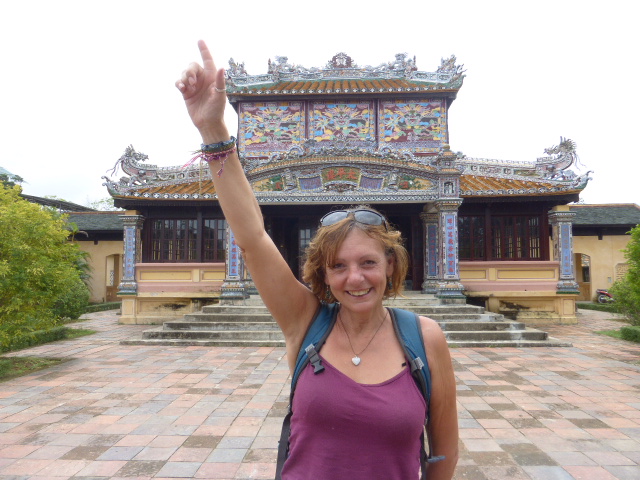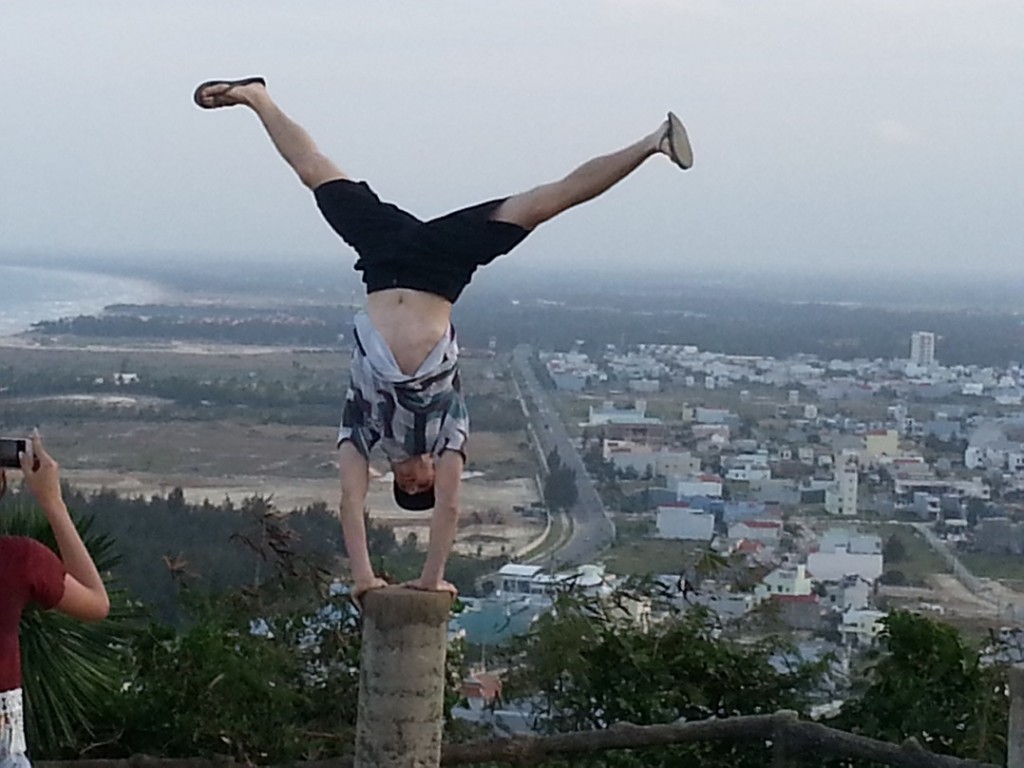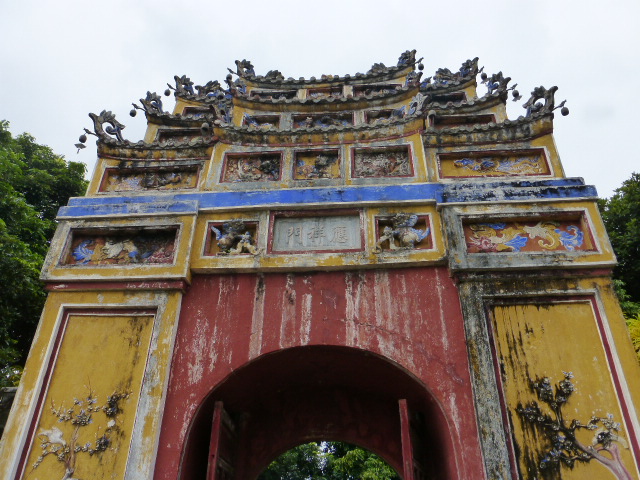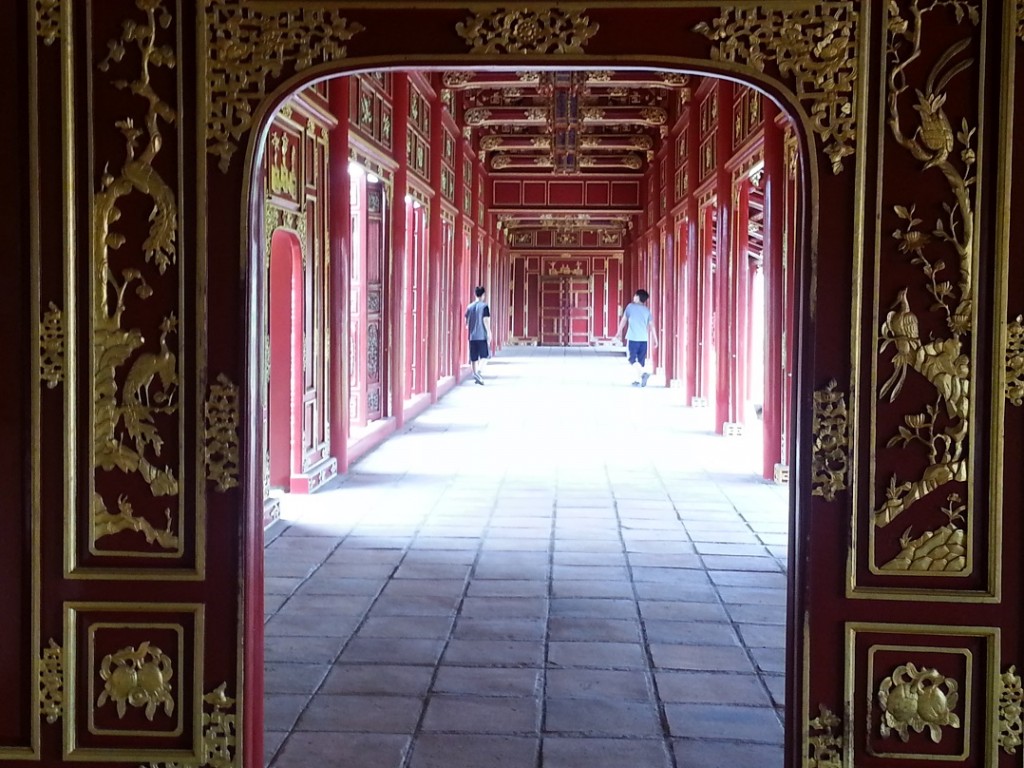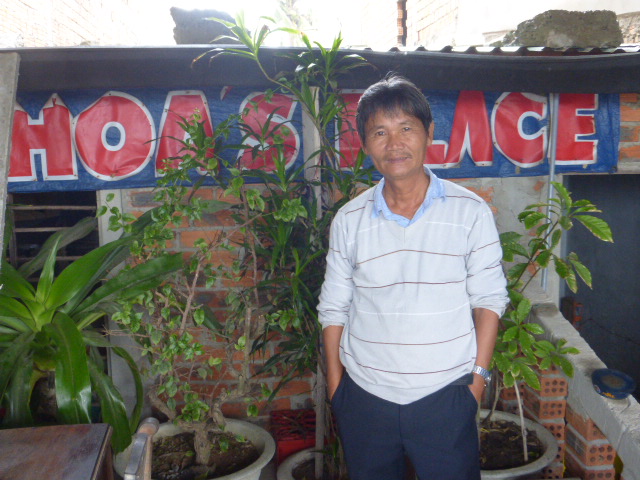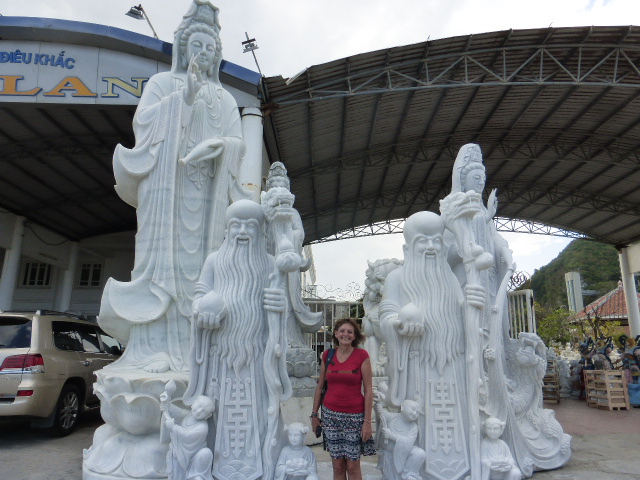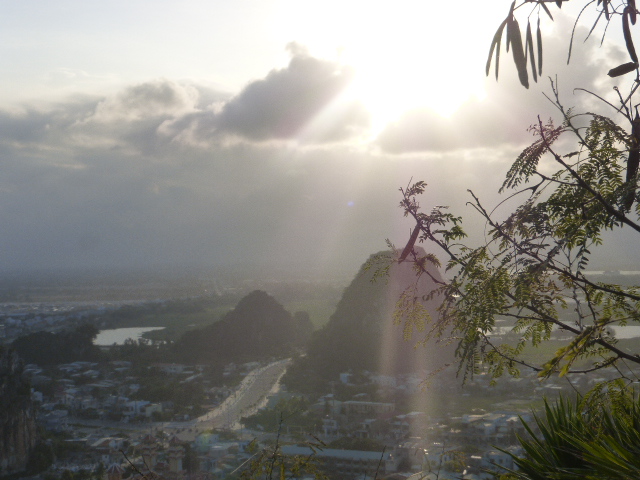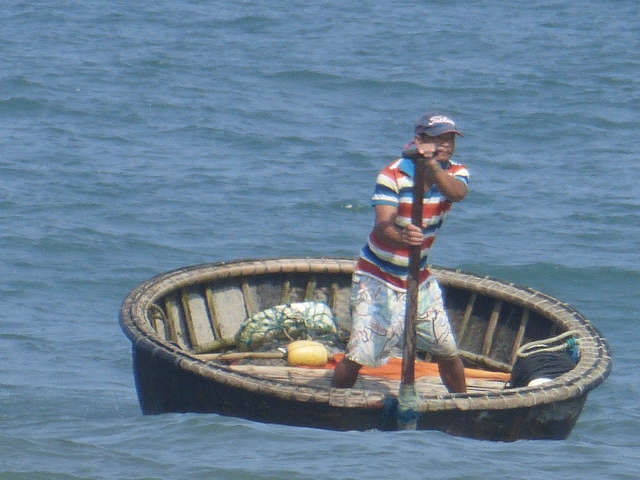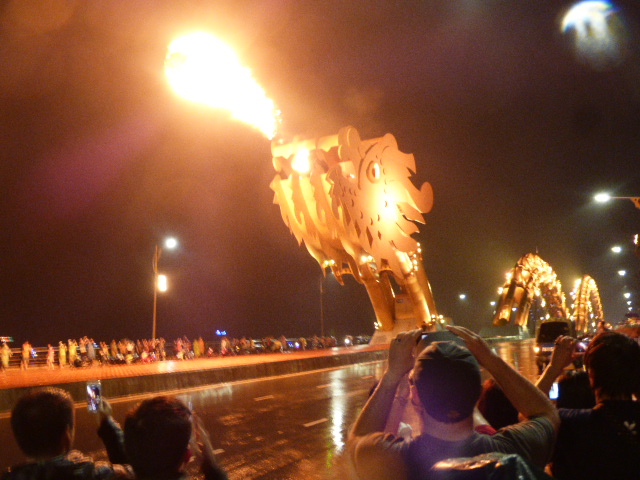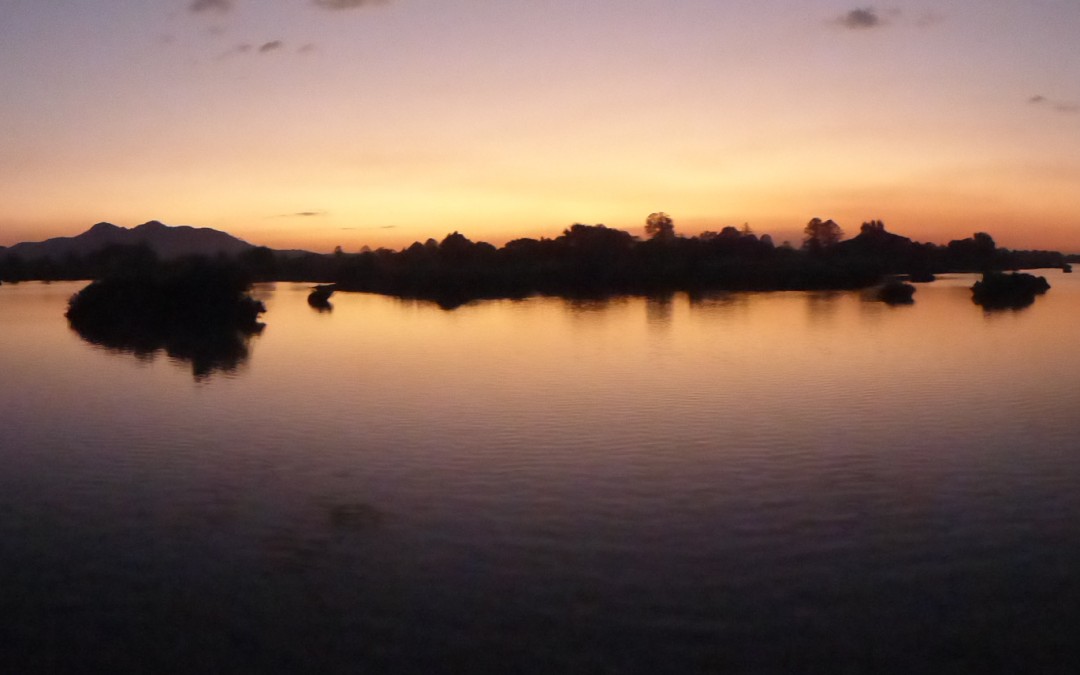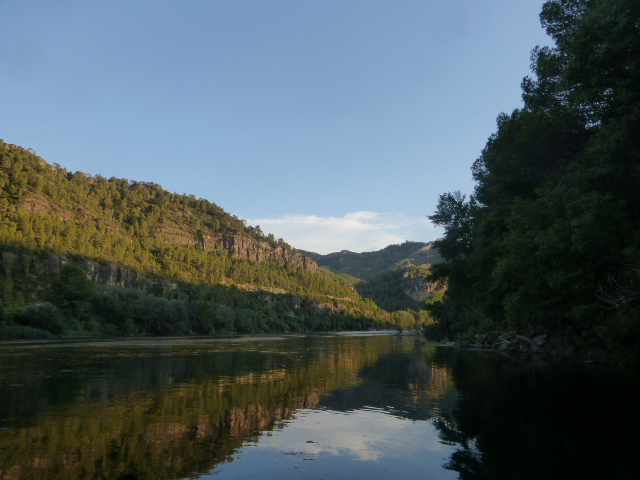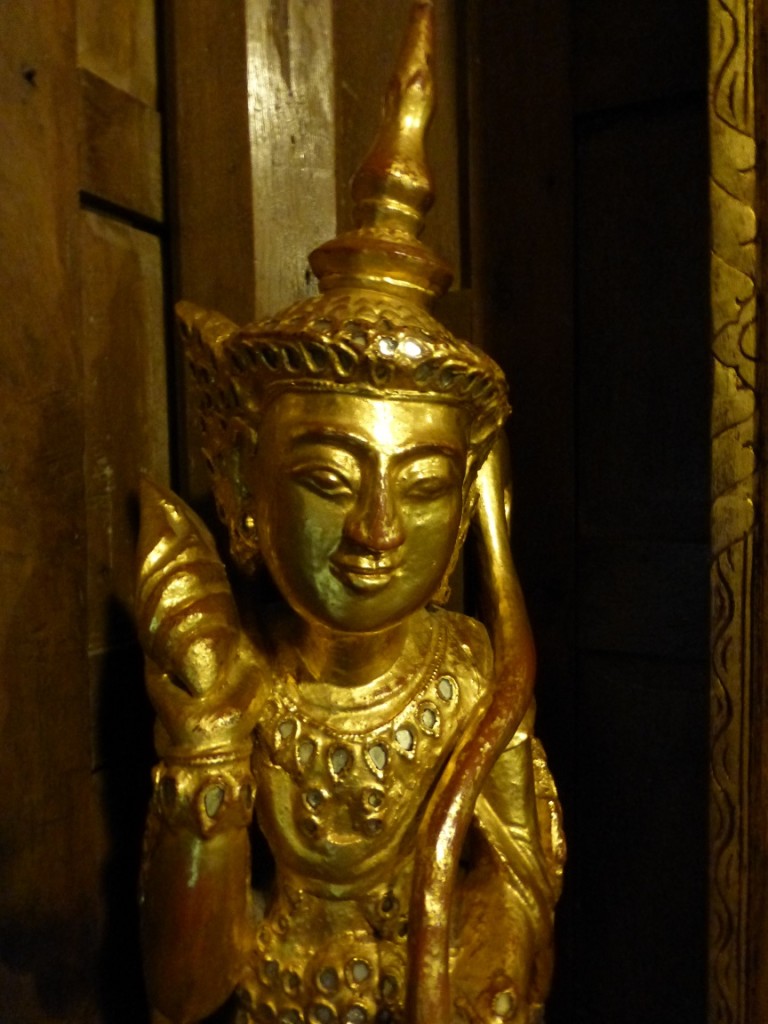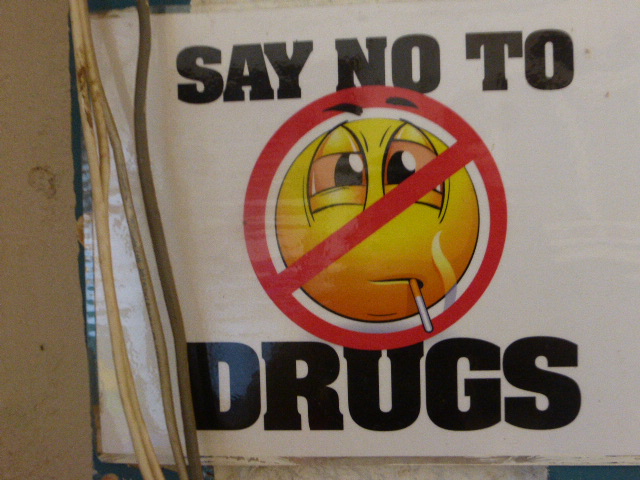
by Jane | Jun 28, 2016 | Asia |
We had crossed the border from Laos and we had travelled by bus to Hue which is a large city near to the coast in the middle of Vietnam. In order to avoid the cold weather we had crossed just where the climate changes and where the country is divided by a range of mountains. We planned to head south from Hue to Danang.
At first, after a month of peace and tranquillity with the down to earth people of Laos it took us quite a while to warm to Vietnam.
Hue
Gosia and I arrived in Hue quite late at night and we were quite overwhelmed by the noise and the chaos that surrounded us as we stepped off the bus. It was like South America all over again as touts and porters tried to grab our bags and insisted that we use their taxis.
After the gentleness of Laos the noise was confusing and disorientating.

Hue to Danang – feeling disorientated after Laos
Neon lights flickered, horns blasted and the fumes from the motorbikes burnt our eyes and throats.
We had a night booked in a hostel and arriving there a party was in full swing. What on earth had we let ourselves in for?
The Perfume River runs through the city of Hue. Some lovely walks through parkland run alongside much of the river. Modern office blocks and hotels rub shoulders with some lovely old houses. Workers in business suits walk past shoe-shine men and traders who squat on the pavements. And there are motor bikes everywhere.
We spent a couple of days in Hue acclimatising to a new language and new customs and window shopping. It seems that everybody in Vietnam is a tailor or a seamstress and whole streets are dedicated to the craft of dressing you beautifully, quickly and cheaply.
The Imperial City and the Citadel
Probably the most impressive attraction in Hue is the Imperial City. This massive complex is sited inside the Citadel – the whole of which is surrounded by walls and a moat. Inside are many areas, including the Purple Forbidden City.

the Imperial City
Building began in 1804 and now the area has a UNESCO status to protect it. While there is an effort to rebuild and renovate the damaged buildings it is sad to know that they were destroyed relatively recently during the Vietnamese/American war when house to house fighting took place in Hue.
I spent a good few hours wandering around the overgrown grounds with my Turkish friend Eray who I had met at the hostel. There are intricate carvings on the doors and roofs and beautiful colours are painted on window shutters and enamel work. Incense burns in large cauldrons and fish swim in ponds, yet in other places piles of rubble lie as testimony to the war.

the Imperial City
The train from Hue to Danang
Despite the ancient city we couldn’t really settle so we decided to head south from Hue to Danang. The guidebooks told us that both the road and the railway journeys from Hue to Danang are quite spectacular and we opted for the train. The books are right – it is a really beautiful train journey.
The tracks soar high up into the mountains and then swoop down towards the coast, passing through jungle and towns and villages. At every single road crossing were men who were controlling the traffic and waving flags and there were even a couple of people stealing a ride on the top of the train carriages.
Danang
We got off the train in Danang and although we had planned to stay here for a couple of nights we soon decided against it once we had finished our coffee in a little cafe. We asked the proprietor to negotiate a cab for us to the small beach town of My Khe which was nicknamed China Beach by the US soldiers who swamped it for R&R during the war.
The beach is basically a suburb of Danang and is not far down the coast and our guide book told us about a not-to-be-missed hostel there. However, when we arrived in to the little town we were told by a vendor that this hostel had been closed down. Suspicious of a scam to divert us to her brother’s hostel our cabbie phoned our planned destination, spoke to the owner and soon deposited us outside a small bar (no hostel) and proceeded to demand triple the agreed fare from us.
So far Vietnam was failing to impress us!
Hoa’s Bar
Hoa is a small man with a huge heart and he welcomed us into his bar, promising us that he would help us to get some cheap accommodation for the night and he assured us that the price quoted by the cab driver was correct and the staff in the coffee shop had been wrong.
Hoa was chatting with a couple of US veterans who had returned to live in the area and had made it their home and over a beer he told us how he had been forced to close his hostel by the authorities who wanted the land for development and he was now running the bar in this new area by the beach.

Hoa and his bar
After a cold beer and time spent with the irrepressible Hoa we began to feel a bit more positive and we arranged to return the following morning for breakfast and then again the following evening for a traditional family dinner which was to be cooked by Hoa’s wife and sister.
Marble Mountain
The town at the foot of the Marble Mountain is VERY strange. The main occupation of just about everybody is sculpturing blocks of marble into statues.
Some of these statues are massive and destined for temples or large hotels; others are small and targeted at tourists from the line of shops which run along the main street. Running the gauntlet of the touts who were determinedly trying to get us into their shops we set off to climb the Marble Mountain.

These statues were huge
Hundreds of stone steps and pathways crisscross up the steep mountain side (there is an elevator some of the way up for the less able). Temples, statues and pagodas are tucked into every little nook and cranny.
Cave complexes spread into the mountain rocks like swiss cheese where you can find hidden grottos and both Hindhu and Buddhist temples. In the pitch black depths of one you climb up a tight squeeze of a funnel and you emerge on the top of the mountain where you have some spectacular views.
As we looked all around we learnt (by eavesdropping on a tour guide) that there used to be five of these large mountains sticking up from the flat plain but they have been decimated by man’s desire for the marble. The government has thankfully called a halt to any more quarrying but the town still chips away at huge blocks of marble which are transported in from other sites which are presumably being destroyed in the same way.

two of the remaining mountains
I also learnt from the same guide that during the war the Vietcong had a hospital on the mountain – in full view of the American air field and the beaches where their enemy troops lazed around and recuperated!
My Khe or China Beach
China Beach is a long side stretch of white sand and I guess in season is thronged with tourists but for now, Gosia and I had it to ourselves, apart from some fishermen who were paddling their small boats around.
I was particularity fascinated by these boats as they are just like the coracles that were on the rivers of Wales in the past. Their roundness and similarity to corks bouncing along on the waves frightened every water hating molecule in my body although the skill of the fishermen had me in awe.

Fishing
The Dragon Bridge, Danang
After a couple of nights at the beach we decided to give Danang another chance and we set off on a local bus for the weekend. After the hospitality of Hoa and his family we were disappointed to have a total dragon of a bus conductor on the local bus – she insisted on charging us double for the journey – we had to pay a fare for our backpacks even though the bus wasn’t full – and then she made us get off the bus a good forty five minutes’ walk from out destination in the drizzle (it seemed that she understood our not so polite comments about her attitude in English!)
Luckily our hostel was nice and clean and breakfast was included but we were still both totally overwhelmed by the traffic in the streets.
Vietnam has a great culture of what I can honestly say is the best coffee in the world (in my opinion) and countless little cafes and coffee shops are on every street corner. Bizarrely you usually sit on tiny little plastic stools all lined up facing the road – but actually this is perfect for traffic watching which is far more exciting than any television programme.
As we set off for the Dragon Bridge that night our receptionist warned us not to stand close to the head of the dragon. Why on earth not? We had made this special trip back to Danang and we wanted a good view from the road not from the banks of the river where the majority of the people were standing.
The police closed off the road bridge and pushed us all back towards the end. This bridge has a large metal dragon snaking its way across the centre which at weekends breaths fire. The head clicked and whirred and then flames began belching from the dragon’s mouth.
In the darkness and the light drizzle it was hot but not unbearable. Our receptionist obviously was erring on the side of caution and Gosia and I were looking forward to finding a club and going out dancing after the fire demonstration. We took pictures and awed and ahhed with the crowd – and then the flames turned to smoke.

The dragon bridge
The dragon was puffing out steam high into the night sky. Then to our horror, the steam condensed when it hit the cold air…….. and it fell to the ground in a torrent! It was as if a million buckets of water had been tipped over us all at once and we were soaked through to the skin!
There was no escape as wave after wave fell heavily onto us and then we simply had to see the funny side and laugh. There was no dancing for us that night as we made our way back to the hostel and dry out our money, our phones and our underwear.
We had seen a wide variety of things from Hue to Danang but now we decided to get a bus further south to Hoi An. Maybe we would like that town better.

by Jane | Jun 8, 2016 | Asia |
New Year on Don Det and the 4000 Islands
Gosia and I met Delia as we were all squashed in a hot tin box of a bus together on our way to Don Det and the 4000 islands. Squatting uncomfortably on child sized plastic seats in the aisle we were soon chatting away and we decided to stick together and celebrate the New Year in style.
[grwebform url=”https://app.getresponse.com/view_webform_v2.js?u=spPd&webforms_id=13182401″ css=”on” center=”off” center_margin=”200″/]
If you are already travelling in S E Asia and need a guide book, don’t forget that you can get Lonely Planet guide books in electronic format as e-books Click here for the latest offers and prices
I was really stepping outside of my comfort zone by being around all this water and the boats but I wouldn’t have missed this part of Laos for the world.
You don’t have to go as far as Laos to challenge yourself but if you would like to find out what you are capable of, then take a look at this link and see what the The Smash the Pumpkin Project can offer you.
Andn case you don’t get to Don Det and the 4000 islands, you can live vicariously through my eyes in this article.
The 4000 Islands lie at the bottom tip of Laos and they share this section of the Mekong River with Cambodia.

One of Don Det’s famous sunsets
Many of the islands are little more than lumps of rock with a couple of trees growing on them but others have a well developed tourist industry and they support a population who get on with their lives as they have done for generations.
We were on our way to Don Det – not to be confused with Don Dhet. Don Det is one of the smaller islands with a focus on budget and backpacker travellers and we had heard that it had a relaxed vibe.
Arriving on Don Det in the 4000 islands
We first had to take a ferry ride over to the island’s sandy beach. Our rucksacks were all piled at the front of the boat and the passengers were warned not to move once we were seated or the boat would tip over – and then thankfully quite quickly we were landed on the hot sand over on the island.

Arriving at Don Det
There are a couple of brick built hotels on Don Det but the majority of the accommodation is in wooden cabins or bungalows. Many of these are built on land which has been in families for generations and they now cater to the increasing influx of travellers.

our home on Don Det
You can choose to stay on either the sunrise or the sunset side of the island – although don’t worry too much because, especially at the pointy bit, it is literally a three minute walk across to the other side.
Most of the bungalow groups have river-side settings, many have restaurants on decking which hang over the water and nearly all are completely laid back, chilled and relaxing. – Click here for up-to-date prices for accomodation from Agoda on Don Det

view from our balcony
Things to do on Don Det
We hired some bicycles and we spent a day touring the length of the island, crossing over the old stone bridge to the even smaller island of Don Khone (which is not to be confused with Don Khong).

Chilling on the bridge
The centre of both islands is given over to rice fields, those cute little Laotian brown cows with their magnificent eyelashes, fruit plantations and vegetable gardens.
The main attraction on the island of Don Khone are the spectacular Somphamit Li Phi waterfalls.

The Mekong
At one point on the side of Don Khone, the normally sedate river Mekong is forced to tumble through chasms and down the rocky river bed. From our vantage point we stood for ages watching the water roar and pour its way angrily southwards.
The local fishermen spread their nets and fishing traps in the rapids and anybody wanting to tube up the river around Don Det is warned to get out of the river long before this point or risk getting swept down to Cambodia.
Where the river settles down again it widens out and you can see across to Cambodia. Here you can see why the area is known as the 4000 Islands, and it is here at this point that you may have the opportunity to watch the increasingly rare Irawaddy dolphins.

Stopping to chat to a local man
Organised boat trips are available from the agents in the little town, but you can arrange one yourself and here at the southern-most tip is where you can bargain for a local guide to motor you out to the ‘pool’ where the dolphins like to chill during the day.
We almost hired a boat – it was cheap enough – but people coming in told us that it was the wrong time of the day to see the dolphins doing anything but lying on the surface and it was all a bit sad.
The boats generally keep a respectful distance from the animals – but we didn’t really want to cause them any undue stress so we declined to go out.

bathtime
Party Central
We had come to Don Det knowing that it generally catered to the backpacker brigade and we were hoping to catch a few parties. It was New Year after all and a beach party was advertised.
There was only one small beach on the island – where the boats from the mainland come in – and there was to be music, dancing, drinking and celebrations.
We wandered down and picked our spot on the sand. Clusters of people were quietly chatting and drinking and music was played over some loudspeakers by a group of teenagers.
Unfortunately they didn’t seem able to be able to agree to anything and they kept cutting tunes off halfway through or switching from dance and trance to folk music as they argued. So the dancing never really got off the ground and anyway the majority of people were just too chilled to even think about standing up or moving in any way.
Midnight struck – or somebody shouted that it had, and we did all jump to our feet to hug and kiss friends. A few intrepid men stripped naked and ran screaming and shouting into the water, only to be quickly ordered out again by police who were paranoid about yet another tourist drowning in paradise.

Don Det and 4000 Islands
We were now into 2016 and we were given the nod about another fantastic party that would be taking place far away from prying eyes.
We wandered down the sandy track into the dark and into the interior of the island. The stars here were wonderful as there was no light pollution and we found a bunch of people cooking and eating pizzas. We made ours up and popped them into the makeshift oven and waited for the party to get going.
Like just about everything else on the island it was all too much effort and a little bit disappointed that we still wouldn’t be able to party we left. We heard that the party never actually did get going but we went back to one of the bars and we had a few cocktails.

more chillin’
You can get hold of drugs everywhere in Laos and especially in the tourist areas, although I wouldn’t recommend you do take them because the penalties are very high if you are caught in possession of them.
We had only just arrived on the slow boat from Thailand to Laos when were offered weed and/or opium and here on Don Det island weed was freely smoked in certain of the bars and some of them advertised ‘happy’ pizzas or ‘happy‘ shakes.
Maybe this contributed to the relaxed atmosphere, maybe it was the hot weather or the decks lined with floor cushions and where nobody objected if you lazed around all day, but whatever the reason, the 4000 Islands is the perfect place to kick back and unwind.

Don Det and 4000 Islands
We would wander a little bit, occasionally cycle around if it wasn’t too much effort, lounge around and chat or sit on the decks and we would watch the sunsets across the water.
I do think that I should travel with a hammock so that I can sling one anywhere and create my own little bit of paradise – Amazon sell a selection – and whilst not pretty, this one should do the trick – [easyazon_link identifier=”B01F57SZYK” locale=”UK” tag=”scajonblo0e-21″]click here for the link to Amazon[/easyazon_link]

sunset on Don Det
Laos – to sum up
Gosia and I had been in Laos for the thirty days which was the amount that was permitted on our tourist visa and sadly it was now time to leave.
We had travelled from the north-west where Laos borders Thailand and we had spent time in the UNESCO World Heritage Award winning town of Luang Prabang.
I had climbed a mountain in Nong Khiaw with a Catalan and got very sick in the north-east. We had to abandon our plans to go across to the cave system close to the Vietnamese border due to the freezing cold weather, the rain, the mud and my stomach.
We` had been privileged to be a part of the Hmong New Year festivities and we had witnessed their courtship rituals and we had found out about the shocking legacy of the ‘Secret War’.
I had tubed down the river in Vang Vieng and we spent Christmas Day dining on fish on the same river as it flowed through the dusty sleepy capital Vientiane.
We fell in love with Champasak and we totally relaxed on Don Det on the 4000 Islands.

catching supper on Don Det
We didn’t have time to do any of the classic motorbike routes through what I have heard is beautiful unadulterated mountains but we did see rescued bears, waterfalls and millions of wooden houses where people live as they have lived for generations.
Can you see the link which runs through this article and binds all of these places, and Laos together?
It is the River Mekong. It forms the border for much of Laos with Thailand and later Cambodia and the main cities are all sited along its banks. It is always wide and it usually flows calmly and it breathes life into this magical country.

the river Mekong
It provides food, irrigation and a means of transport. It provides hydro-electric power. It is the life blood of Laos.
Much of Laos is underdeveloped and is still covered in jungle and forests and the Laos people are gentle, softly spoken and extremely shy.

the people are all beautiful
The nation is immensely poor and it is stuck in poverty partly because of the Secret War. The women are very beautiful, the food is generally simple and the countryside goes on for miles and miles.
If you are reading this and wondering whether it is worth a visit – YES it is.
Do go.
Do not be confrontational and do speak gently.
Be prepared to witness entire busloads of Lao vomiting into plastic bags because they all get travel sick and please don’t eat anything from a roadside cafe in the mountains that looks and smells like road-kill!
Gosia and I were unable to leave Laos without a nightmare thirty six hour journey.
I had a panicky couple of minutes when I thought that I was being kidnapped and we got stuck for the night in a town where packs of feral dogs reigned after dark, but we finally left the peace and quiet and the gentleness of Laos for Vietnam.
Boy, were we in for a shock!
I have mentioned the books of [easyazon_link identifier=”1849165181″ locale=”UK” tag=”scajonblo0e-21″]Colin Cotterill[/easyazon_link] in previous posts but he really does write beautifully and describes the countryside, the people and the traditions of Laos so well. You can see some of his books in the Dr Siri series here
[easyazon_infoblock align=”none” identifier=”1849165181″ locale=”UK” tag=”scajonblo0e-21″]
Sign up here (fill in the details in the box on my home page) so that you don’t miss my soon to be released articles about Vietnam and you can find out whether I loved or hated that country, and please, please, please DO NOT travel without decent insurance – I use Alpha Travel Insurance – you can get your free quote here
To accompany this series of articles on Laos, I have published a comprehensive 28 page travel itinerary of my month-long route around Laos. Simply enter your details in the box below to get your free guide.
[grwebform url=”https://app.getresponse.com/view_webform_v2.js?u=spPd&webforms_id=13109801″ css=”on” center=”off” center_margin=”200″/]
And if you simply want to follow me and not receive the comprehensive Laos guide you can enter your details here
[grwebform url=”https://app.getresponse.com/view_webform_v2.js?u=spPd&webforms_id=13127101″ css=”on” center=”off” center_margin=”200″/]

Pin and share this post

Share and pin this post to read later
This post contains affiliate links and/or references to our advertisers. We may receive compensation when you click on or make a purchase using these links.
Scarlet Jones Travels is a participant in the Amazon Services LLC Associates Program, an affiliate advertising program designed to provide a means for sites to earn advertising fees by advertising and linking to Amazon.com.

by Jane | Oct 27, 2015 | My travels |
What are the dangers faced by travellers?
There are countless dangers faced by travellers but I suspect that you haven’t yet considered the following three points. They are not up there with getting stuck in very close proximity to a bathroom for a week because you couldn’t resist the street food or waking up after a night on the lash with a tattoo on your bum, but they are very real dangers nevertheless.
Actually the list could be endless but here are 3 of the dangers faced by travellers.
#3. Meeting people
A full contact list can be a bonus. A busy Facebook friends’ list is a reminder of happy travels and shared memories but unless you have a great memory, do keep notes.
After travelling around a continent it may be hard to differentiate which Juan is which several months after you have parted company.
This is no problem until you want to contact one Juan to meet up for a beer and then you have to hide your surprise when a different Juan arrives and you spend the evening frantically making small talk.
#2. Travellers lose things.
They either lose themselves metaphorically speaking or geographically, or they lose physical items.
I seem to lose underwear. After rinsing items through in the shower I have a tendency to leave my knickers draped over shower heads and taps in hostels.
If you follow my blog you will also know that I am often getting lost. I spend hours retracing my steps, sitting in little cafes and studying maps or wandering around museums after taking a wrong bus or a wrong turning.
But in my mind, getting lost is a good thing. You can discover hidden gems and make new friends, and you can lose yourself – just make sure that you get out of town before you turn into that rambling hippy on the beach who took the wrong turning twenty two years ago.

wristbands – a danger of travelling
#1. The hidden danger of travelling – the wrist band
Many travellers adorn themselves with colourful bands around their wrists. These scrappy pieces of woven cord and fabric tell a story, plotting ones journey and prompting memories of friends met.
But these cloth bands can be lethal.
The stray ends dangle in food, drinks and on plates, collecting microbes and passing on germs. The situation is not quite as dire as you might expect because on the upside, everytime you take a shower they do become clean again.
The biggest hazard is fire. Stirring supper over a gas flame, the careless or hungover traveller can quite easily find flames licking up their bands, although after time, this propensity to burn appears to diminish, probably in direct correlation with the amount of dirt that they become coated in.
To sum up
There are many dangers faced by travellers but sometimes it is the small ones that can cause a melt down and a panic rather than the larger dramas which crop up.
If you want to travel, don’t let anything put you off – get out there and give it a go.
If you want to read about a REAL danger – such as the time that I faced a potential robber who was armed with a knife, Click here

by Jane | Oct 13, 2015 | Rest of the World |
Two and a half years ago I quit my job and I went exploring.
I thought that I may be gone for no more than a year before I satisfied my wanderlust and I settled back down again.
Europe 2013
How wrong was I! I really threw myself in at the deep end that first summer in Europe.
- I went to to my first ever proper festival (in Lisbon),
- I worked on a farm in the Algarve,
- I was house sitting in Italy
- I looked after (sort of) 7 golfers in a gite in France
- I went to a wedding in Gibraltar
A year in South America

Scarlet Jones Travels – Brazil
And then I fulfilled my childhood dream (thanks Paddington Bear) of going to deepest darkest Peru. I was in South America for 364 days but I hardly scratched the surface. I usually travel slowly and I try to integrate with communities so I didn’t cover half of the ground that I had planned to, but I did manage to get to
- Peru
- Bolivia
- Ecuador
- Colombiaaaaa
- and Brazil
After a month or so in the UK over Christmas and the New Year I spent nearly a week in Tampere in dark snowy Finland before heading back to Spain for a break and I prepared for my next adventure – which was…..
Blasting through the Baltics.
The initial plan was to travel from Finland to Morocco in a camper van with a friend who I had met in Colombia but stuff got in the way and I had to fly back to the UK from Warsaw. However I did manage to see Helsinki, and then the Baltic countries of Estonia, Latvia and Lithuania and the top right-hand corner of Poland. Those few weeks were crazy and emotional for many reasons (you will have to wait for the book) and the weather threw everything at us from the most idyllic winter weather ever in Helsinki and Estonia to blizzards, icestorms and biting winds at other times.

Scarlet Jones Travels – Estonia
I spent my third summer away from my 9 to 5 job…
Cavorting in Catalunya
I worked hard and I played hard. I spent HOURS tapping away at my keyboard, designing an on-line course (watch this space as it will be launched very soon now). I would often put in more than 10 hours a day writing content but luckily I found plenty of time to explore the region led by my willing accomplice Debs.
And that brings me to now. Two and a half years on I am just beginning a new chapter – this time in South East Asia. I have a very loose, tentative plan, an idea of a route around the region, but if travel has taught me anything it’s to not over plan so I’m not going to set it out in print at this stage.
What I do know is that I will spend some time in Bangkok where I am very excited to be attending my second TBEX (Travel Bloggers Conference), and then…..well, you will have to wait and see.
I will also be launching my on-line course very soon and as a result of that I may have to rent a room somewhere and base myself in a place with decent wifi in case there are any last minute glitches with the launch.
And I don’t know why, but dramas always seem to follow me around and this trip so far has been no exception. Getting to Thailand was always going to be a bit of a slog but I had managed to buy an excellent value ticket with a decent travel time and just a 2 hour transfer in Mumbai. And then, just 17 minutes in to my overnight coach journey to the airport I received an email which told me that due to ‘an incident’ over Turkish airspace my flight had been seriously delayed and I would miss my connection.
Yes – things are back to normal!
If you would like to receive my blog articles directly by email and read what other dramas are going to befall me – you can guarantee that there will be many – make sure that you go to my site and sign up. You will also get a free copy of the ‘Top 10 things that you should know before travelling’ and you will be one of the first to learn about my course when it launches.
Are you ready? Watch this space for…
Scarlet Travels Solo in South East Asia

Scarlet Jones Travels – Bangkok

by Jane | Aug 25, 2015 | South America |
Trekking in the lush mountains ‘somewhere’ in Colombia and looking over the steep hillsides which were jam-packed with stubby glossy-green coffee bushes I asked my local friend about the money that the farmers here would earn from their beans. He told me that the farmers here could not receive a good price at all for their beans on the market but that they were financially very well off, thank you very much!
After meeting Jorge the coffee farmer earlier in my travels (read that article here) I wondered how the farmers in this area earned their money. They didn’t even appear to have the usual secondary crop of plantains or bananas growing alongside the coffee, yet they had extravagant homes and cars in the mountains.

My friend expanded upon his story but he asked me not to identify where we were walking. It transpired that the majority of the mountains that we could see, and many more beyond, were owned by just one wealthy man. That man had earned his wealth through the little white powder that Colombia is famous for, but now, with the authorities becoming more vigilant he had to somehow justify that wealth. So he bought a mountain; the land and the farmers.
The farmers continue to farm their coffee (they have no interest in planting additional cash crops), and in exchange, this man pays the farmers top prices for their beans, which for now, satisfies the authorities. It is money laundering.
Whether the wealthy landowner still trades in his sideline of ‘white coffee’ or if he has retired from that more lucrative career path I am not sure, but the local farmers don’t appear to care whilst they are receiving the money.
And there is a market for the ‘white coffee’. Whether among the local population or for the tourists, across South America drugs of any description are cheap and easily available.

I certainly would never want to be caught with any illegal substances on me as sentences can be exceedingly harsh but there is corruption among some of the police in some of the countries and that actually makes things easier. If they catch you with something, yes the majority of officers will follow the law but a huge proportion will ensure that they personally benefit.
I met one guy who was stopped by the police in Cartagena and searched. They found something on him and luckily they gave him a telling off, confiscated it (no doubt they would use it themselves later or sell it on) and told him to be on his way. Chancing his arm, my friend cheekily asked if they had anything for sale – to which they replied that they knew that he didn’t have enough cash on him, but left him in no doubt that if he did, he could have been in a position to buy it back from them!
Men stand on every street corner in South America selling things – from chewing gum and tobacco to shoe laces and tissues and they all whisper as you walk past, asking if you want to buy something special. My advice here is DON’T. Many will not sell you the real deal, others are in cohoots with the police and will follow you and report you in exchange for a pay-off. But it is all out there and it is cheap.
In Colombia you can buy little 1 gram bags of the white powder for between $4 and $7 and weed will cost you just $1.50 per gram. The temptation is there, but do remember that the recent history and the devastation of entire families in Colombia is all caught up in the recent wars between the drug cartels and by buying into the trade you may be perpetuating the problems.

I was very upset when I met a Colombian policeman in Ecuador who was on the run and in hiding with his wife and two children following the assassination of some of his family after his role in the anti-narcotics force was uncovered. I doubt that my ‘practical research’ into the trade contributed much to the overall situation, and I have to confess to certainly enjoying the many and varied fruits of the country while there, but who knows.
The country is still raw from the black period in history and there are still restrictions which hang over the people. It was until relatively recently illegal for 2 men to ride pillion on bikes as so many were gunmen and while that rule has been relaxed there are still prohibitions. On election days, people are not permitted to go out with a pillion rider (previously there would have been drive-by shootings from motor bikes and also in some areas of Cartagena on pay day, pillions are barred due to the high prevalence of drive-by bag snatches.
The worlds of the ‘white coffee farmer’ and Jorge who is striving to change the system for all of the coffee farmers in his area are poles apart, but it is people like Jorge and Juan – ordinary people at grass roots level who are the ones who will eventually make a difference and change peoples’ perception of Colombia.
And people like you – tourists and visitors who go with an open mind and take much needed revenue into the country.
